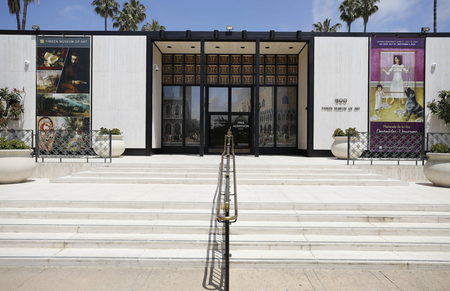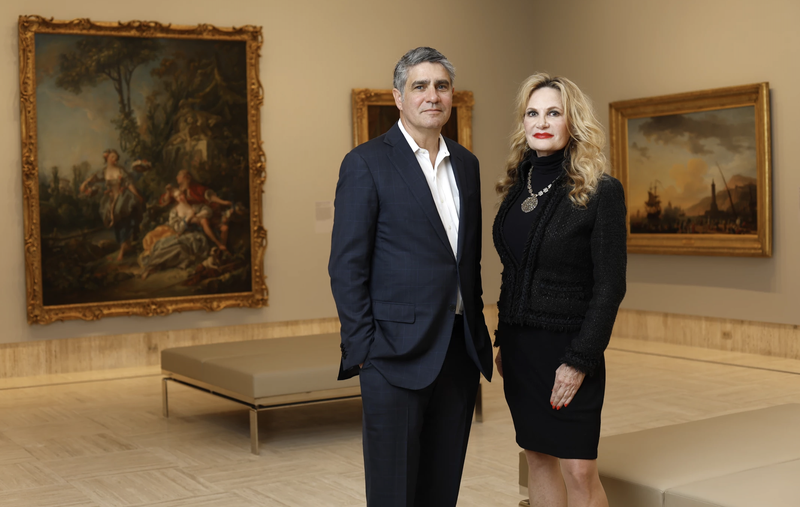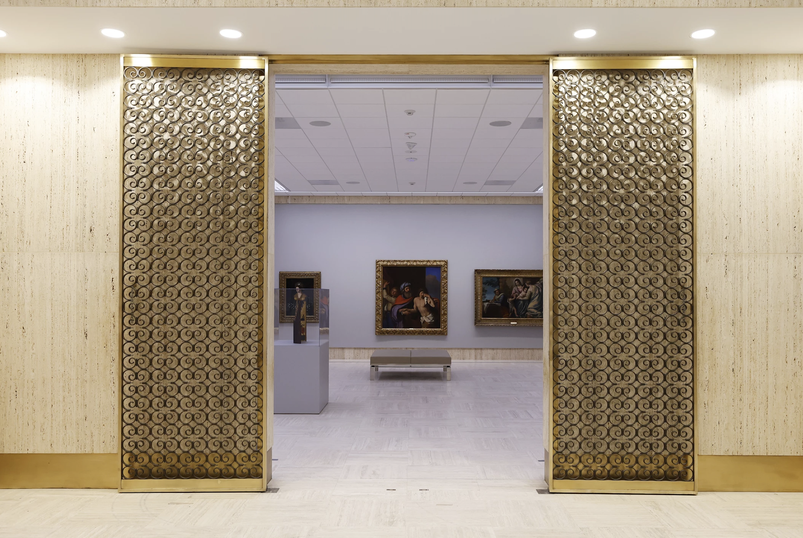As the foundation continued to buy paintings, Ames sought to find a way to keep the Putnams’ impressive collection in San Diego. He turned to his client Henry Timken Jr., whose family had made a fortune in roller bearings.
The Timken Foundation agreed to finance construction of a new gallery, which was proposed as a “wing” to the Fine Arts Gallery. The architectural firm of Frank L. Hope and Associates was commissioned to design the building, but the firm’s vision of a simple, symmetrical, ultra-modern building that would embrace Balboa Park from within wasn’t what city leaders had in mind.
They wanted something that would fit with the architectural style of the park’s buildings from the 1915 Panama-California Exposition and the 1935 California Pacific International Exposition. Despite opposition, the Timken’s design was approved by the city because Ames had threatened to take the collection elsewhere if it wasn’t. The park’s Home Economy Building, designed by architects Carleton Winslow and Bertram Goodhue, was razed to make way.
The 10,400-square-foot museum, which opened in October 1965, was constructed with travertine marble, bronze and glass and is now considered to be among San Diego’s finest examples of midcentury modern architecture.
“It is an incredibly well-built structure with concrete walls and three-quarter-inch plywood. It’s very solid,” Cartwright said.
“The building is part of our collection,” Pogue said. “It’s the only see-through building in Balboa Park.” Glass surrounds the east- and west-facing doors for views of the Plaza de Panama and the lily pond. Inside, full-length glass windows connect the interior with courtyard gardens.
Years of patina have been removed from the bronze baseboards and the ornamental accents, delicate florets in lace-like patterns that wash like waterfalls down interior doors, exterior screens and surrounding fences.
Clean air
Much of the time and cost of the restoration went into upgrading the mechanical systems. The new high-efficiency dehumidification system is outfitted with antiviral technology originally engineered in conjunction with the Department of Defense.
“The Timken’s reopening is an example of how institutions, including The San Diego Museum of Art, are placing importance on the visitors’ experience, particularly following the pandemic. Among its renovations, we understand the Timken has made several improvements to ensure guests’ safety during this COVID era and beyond, and we applaud these efforts,” Velásquez said
The antiviral system, which uses ultra-fine HEPA filters and ultraviolet light, is expected to remove 99.9 percent of airborne pathogens.
“We are the only museum in the world to have that technology,” Pogue said.
Plans for renovations began about five years ago, so when COVID closed everything down in 2020, the time seemed right to start the work. The Timken Foundation — now known as the Timken Foundation of Canton — once again stepped in, paying for the bulk of the improvements. The Helen Frankenthaler Foundation contributed $100,000 for the HVAC system.
Pogue envisions having more programming at the museum. To that end, audiovisual equipment was installed in the museum’s central space. Plans are underway to have more music programming and lectures.
“We are very small, and people appreciate that post-pandemic, with smaller, more intimate events,” Pogue said.
The Timken has also partnered with a number of Balboa Park institutions, including the San Diego Railroad Museum, to exhibit the Timken’s popular Christmas ornaments and the San Diego Zoo with an animal-themed exhibition to celebrate the zoo’s centennial.
“The Timken is committed to be a partner with all other institutions,” Pogue said. “I love the collaborative aspect of the Timken. Our aim is to have art without barriers.”
“We will never change who we are, but we can enhance who we are,” she said.
A timeline: Timken Museum of Art
1951: Putnam sisters Anne and Amy establish the Putnam Foundation.
1965: Timken Art Gallery opens with a collection of 20 masterpieces and 20 loaned from the San Diego Museum of Art. Executive Director: Walter Ames plus 1 full-time employee. Annual attendance: 27,520.
1969: Timken Art Gallery produces the first catalog of its European painting collection. Annual attendance: 89,113.
1975: Collection grows to 37 masterpieces. Twenty loaned paintings return to the San Diego Museum of Art. Annual attendance: 70,808.
1979: Nancy Ames Petersen became the Museum’s Executive Director (1979 to 1995). Purchase of Bartolomeo Veneto’s “Portrait of a Lady in a Green Dress.” Annual attendance: 67,966.
1984: Purchase of John Singleton Copley’s “Mrs. Thomas Gage.” Formal docent training and education programs are initiated. Annual attendance: 77,424.
1985: Friends of the Timken membership program begins with 25 members. Annual attendance: 83,170.
1986: First focus exhibition: “Albert Bierstadt: Cho-looke, The Yosemite Fall.” Annual attendance: 79,996.
1990: Twenty-fifth anniversary of the Timken. “Eastman Johnson: The Cranberry Harvest, Island of Nantucket” exhibition. Annual attendance: 92,816.
1992: Timken Art Gallery renamed to Timken Museum of Art. Conservation of Petrus Christus’ “Death of a Virgin” completed.
1995: Nancy Ames Petersen retires. John Petersen becomes Executive Director. Annual attendance: 84,125.
1996: Outreach Español program begins. Docent tours and school programs expand.
1999: Conservation of Rembrandt’s “Saint Bartholomew” completed. Acquisition of Niccolò di Buonaccorso’s “Madonna and Child.” Annual attendance: 102,290.
2005: 40th anniversary of the Timken. “Rembrandt’s Apostles” exhibition. Acquisition of Anthony van Dyck’s “Mary Villiers, Lady Herbert of Shurland.” Annual attendance: 113,000.
2008: “Kimono as Art: The Landscapes of Itchiku Kubota” exhibition in collaboration with the San Diego Museum of Art. John Wilson becomes Executive Director. Annual attendance: 140,800.
2011: First government funding from the City of San Diego and County of San Diego. Membership grows to more than 220 members. “Robert Wilson: Video Portraits” exhibition. Attendance grows to 165,000 annually.
2012: First collaborative exhibition with the San Diego Museum of Art and the Museum of Contemporary Art: “Behold, America!: Art of the United States from Three San Diego Museums.”
2016: Derrick R. Cartwright appointed Director of Curatorial Affairs.
2015: Megan Pogue appointed Executive Director. Annual attendance: 183,784.
2017: Annual attendance: 250,690.
2019: Annual attendance: 240,842. Spring 2019 exhibition: “Metonymies: A Dialogue with Twentieth-Century Works from the Sonnabend Collection.”
2020: Exhibition: “Captivating Women from the Dijkstra Collection.” Sandra and Bram Dijkstra donate Ella Ferris Pell’s “Salomé" (1890) to the Timken. The work is the first painting by a female artist to be added to the museum’s permanent collection. Museum closed March 17, 2020 due to COVID-19. Extended self-closure to enable a visitor-enhancement renovation.
# # #



